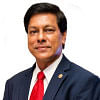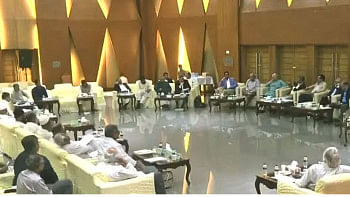Bangladesh: Out of the basket

Almost immediately after the independence of Bangladesh, Henry Kissinger, former US Secretary of State, dismissed the country as a "perpetual economic basket case". Bangladesh has proved Kissinger wrong. In the last forty four years, Bangladesh has undergone a great deal of transformation. There has been some good progress in almost all spheres of life, but still for some Bangladesh means a country of floods, cyclones, poverty, over-population, political turmoil, corruption, Rana plaza etc. These negative events cast a shadow on the many achievements that we have made in the last 44 years. For a change, therefore, let us talk about a positive Bangladesh.
Since half of our population is directly or indirectly involved with agriculture, we will start with this sector. Our main produce is rice; besides we grow wheat, jute, vegetables, fruits etc. In 1971, there were 75 million people in the country and the country's rice production was only 10 million metric tonnes. Presently, our population is around 160 million and to accommodate this extra-large population we have lost a significant area of cultivable land; but rice production, nonetheless, tripled in the last 44 years to over 33 million metric tonnes, as it now stands today. Thanks are rightfully deserved by our poor farmers, who are not only feeding us but have also made the country self-sufficient in rice production. According to Food and Agriculture Organisation (FAO), Bangladesh is one of the leading countries in the developing world, in fact the first in Asia, to have a comprehensive country-investment plan for agriculture, food security and nutrition.
Since independence, our country has also made significant strides in other economic sectors. Many industries were established, but successes and a considerable progress were made by the garments, textiles, pharmaceuticals, ceramic, cement and many other sectors. Garments alone have around 5,000 manufacturing units, creating employment opportunities for 4.2 million people, of whom 85 percent are women. In fiscal year 2014-15, the country made approximately US$ 26 billion's worth of total garments export, which established us as the second- largest garments and knitwear exporting country in the world. Industrial experts are predicting that in the next five years, Bangladesh will become the largest readymade garments manufacturer.
Our leather and leather goods have long been witnessing huge demands in the global market. Fisheries and livestock are playing an important role in our economy. Around 1.3 million people are directly involved in this sector. After garments, shrimp is the second largest export item of the country. In FY2013-14, the country earned US$ 638 million by exporting 55,074 tonnes of frozen foods, including shrimp. Jute, which used to be our famed 'golden fibre', has made a spectacular comeback, as the demand for natural fibre is increasing worldwide. Bangladesh exported raw jute and jute goods worth $1.03 billion in fiscal 2012-13 — jute sacks and bags accounted for $237 million and jute yarn and twine over $500 million — according to data from Export Promotion Bureau. Our pharmaceutical sector and the information technology sector are maturing and have already entered the global market. Both the industries have great potential and will definitely bring fortunes to the country in the near future.
Today, there is probably hardly any corner on earth where Bangladeshi workers haven't migrated. The inflow of remittance was US$23.7 million in 1975 and it rose to US$15.3 billion in 2015.The revenues earned and sent by the migrant workers make the largest portion of our national reserve of foreign exchange which now stands close to $ 27 billion. As a result, the dependence on foreign aid in framing the national budget has reduced to a great extent. Remittances are playing key roles in lifting people out of poverty. Moderate poverty rate declined from 34.3 percent in
2000 to 12.6 percent in 2015.
One feature that we can make out from the above portrayal is that our economic activity is growing rapidly. Back in 1970, the size of GDP was only US$6.2 billion and in 2015, the GDP grew to $205.3 billion taking Bangladesh to the 44th position in the world economy. Total export in 1970 was US$ 0.36 billion which stands today at more than US$34.5 billion. Our per capita income is $1314, which was only $135.62 in 1970. Besides our economic growth, we have also made significant progress in achieving the Millennium Development Goals (MDGs), particularly relating to eradicating extreme poverty and hunger, promoting gender equality and empowering women, ensuring universal primary education and reducing child mortality. In 1990, the infant mortality rate was 100 deaths per 1000 live births, and by 2015, it had been reduced to 30.70 deaths per 1,000 live births. Life expectancy is now 71 years from 47.58 years in 1970.
Cyclones, floods and droughts have long been part of the country's history, but they have been managed successfully by the governments in recent years. Bangladesh is the first country to set up its own Climate Change Trust Fund supported by nearly US$300 million of domestic resources from 2009-2012. In appreciation of our remarkable achievements, the Prime Minister of Bangladesh Sheikh Hasina, has been announced as one of the winners of the United Nations' highest environmental accolade, 'Champion of the Earth' 2015.
Bangladesh is also glorified and known to the global people because of some of our social and personal achievements made by our people. The micro-credit is generally considered to have been pioneered by Grameen Bank, founded by Nobel Laureate Prof. Dr. Muhammad Yunus. Its vast network in the country has 8.4 million borrowers, of which 96 percent are women. It has opened the door to poor rural women, prompting them to participate in the activities of local government, and take greater roles in other community activities. Its success has inspired similar projects in more than 40 countries around the world, including the USA, with 200 million clients. The Grameen Bank has received several prestigious awards, but the greatest recognition for the bank's achievement came on October 13, 2006 when the Nobel Peace Prize, 2006, was given jointly to Prof. Dr. Muhammad Yunus and the Grameen Bank "for their efforts to create economic and social development from below". Recently, Prof. Yunus brought another glory for the nation by getting the highest civilian award of the United States, the Congressional Gold Medal, in recognition of his efforts toward combating global poverty.
Bangladeshi youths, aged 18-40 years, constitute 70 percent of our total population. They are our assets and all of them are working hard to bring changes. Four of them have already brought much glory for us by hoisting our national flag at the top of the world - the peak of Mount Everest. Musa Ibrahim became the first Bangladeshi to reach the summit of the Everest on May 23, 2010. After that, M A Mohit conquered the peak in 2011, and two young women, Nishat Majumder and Wasfia Nazreen, in 2012.
The above are a few snapshots of our many successes. Things are now looking brighter for us. Our economy worth US$ 205.3 billion is growing at the rate of 6.0 percent - making us the next manufacturing hub in the region. Thanks should go to our poor farmers, workers at home and abroad, the entrepreneurs and all the hard working people, who have successfully contributed in taking Bangladesh out of the 'basket case'. However, it is feared that because of our current political climate, the country may again drift back to the basket case branding, it never deserved.
The writer is a businessman.
Email: [email protected]

 For all latest news, follow The Daily Star's Google News channel.
For all latest news, follow The Daily Star's Google News channel. 



Comments